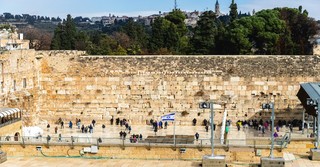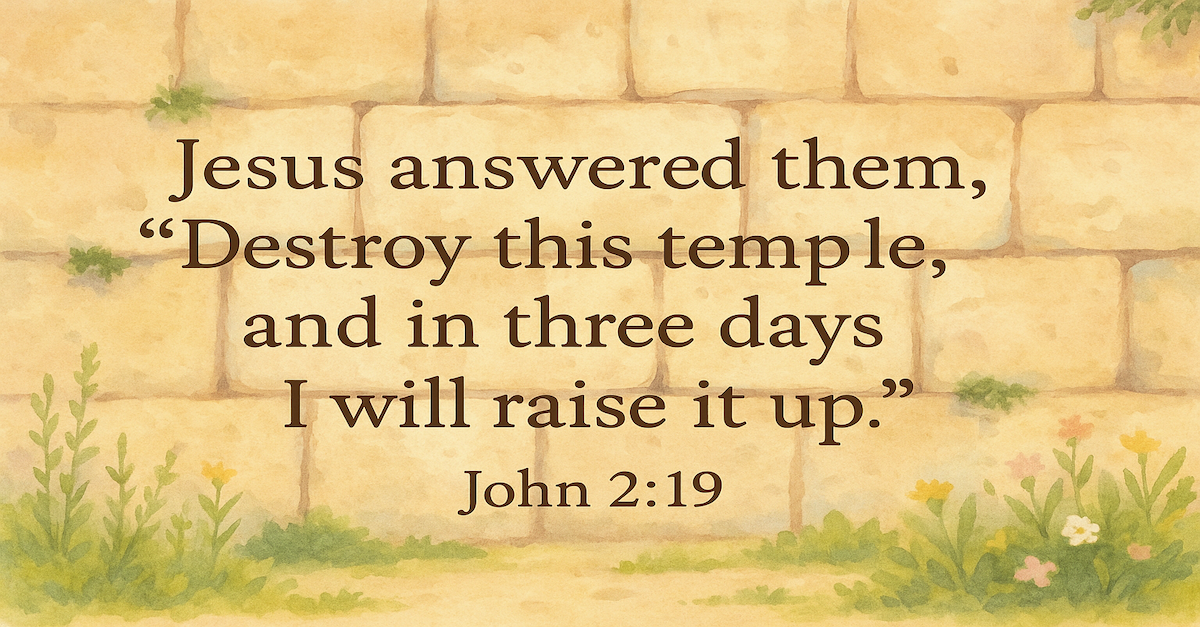What Is the Significance of the Wailing Wall in Jerusalem?
Share

I have a bucket list of places I want to go. I’ve been to a few, like the Great Wall of China and Venice. However, I still have a few remaining on my list. One of those places is Israel and Jerusalem.
I have been a history teacher and a pastor, and I love studying the Scripture. Jerusalem is important in past and current events, and of course, much of the Bible takes place in and around that city.
For many who visit, the Wailing Wall becomes a main attraction and destination. Jews make pilgrimages to it, and Christians find it important, as well.
What Is the History of the Wailing Wall?
The Wailing Wall, also known as the Western Wall, is one of the most sacred sites in Jerusalem. It remains the only part of the Second Jewish Temple that survived the temple’s destruction by the Romans in 70 AD. Herod the Great expanded the Second Temple around 20 BC, and Jesus engaged with this temple during his lifetime. However, the Jews revolted against Roman control after Jesus’ death, and the Romans defeated the Jews and destroyed the temple as a consequence of the rebellion. Only the Wailing Wall was left standing.
Jews started praying at the wall during the first centuries AD, since the site was the closest they could get to the Temple and Holy of Holies, the place where God’s presence dwelt under the temple system. Without a Holy of Holies, however, the Jews couldn’t perform the Mosaic sacrifices, so they turned to prayer and mourning at the wall. By the Middle Ages, Jewish pilgrims and locals regularly gathered at the wall to weep and mourn the destruction of the temple. Because of this grief, the wall is known as the “Wailing Wall.” The Ninth of the Jewish month of Av is a traditional day of mourning for the Jerusalem Temple, and many gather at the wall that day.
The Ottoman Empire kept the Jews from the Wailing Wall with restrictions. The Jews continued to gather as they could. After World War I, the British allowed more freedom for Jews. Muslims had taken control of the Temple Mount, so conflict and violence happened between Jews and Muslims. Even though the Jews were given control of Israel after World War II, the country of Jordan conquered East Jerusalem during the 1948 Arab-Israeli War. The Jordanians banned Jews from the Wailing Wall. As we see a pattern, another war happened, the Six-Day War in 1967, and Israel recaptured the eastern part of Jerusalem and reopened access to the wall for pilgrims and worshippers.
Today, the Wailing Wall continues to be a place for religious prayer and mourning. Thousands place written prayers to God within the stones of the wall. It stands as a monument to the past, but the wall has also become a hope for future restoration. While many call it the Wailing Wall, others prefer the “Western Wall” to express sorrow and joy.
How Is the Wailing Wall Significant for Modern Jews?
The Jerusalem Temple holds central importance for Israel’s history and religion. The Holy of Holies held the Ark of the Covenant, a manifestation of God’s presence, a symbol pointing to how the Lord lived with his people and gave them access to him. King David first tried to build the temple for a permanent home for the Ark instead of the tent (Tabernacle), but God denied David’s request to construct the temple, saying the king had shed too much blood. However, God promised David’s son, Solomon, would build it. Solomon did and built an amazing temple based on David’s design. At its dedication, God’s glory filled the temple, validating it as the spiritual center of the nation.
Because of God’s presence in the temple, all Israel was commanded to gather in Jerusalem for the three main feasts (Passover, Pentecost, and Feast of Weeks). Through the sin and idolatry of Israel and Judah, God exiled the Jews to Babylon, and the original temple was destroyed.
However, God restored the Jews back to the city, and the Second Temple symbolized restoration and hope. It didn’t reach the grandeur of Solomon’s, but it still meant God kept his promise to return the people to their land and reestablish proper worship (Ezra 3; Haggai 2:3-9). To lose the temple a second time in 70 AD, the Jews lost a key part of their culture and identity.
As we see, the Western Wall holds both deep religious and ethnic importance. Today, life events like bar mitzvahs, weddings, and other ceremonies take place there. Even for nonreligious Jews, the Wailing Wall remains significant for their identity, ancestors, and history. The Jews have been spread around the world through various wars and diasporas, so a national monument like the Wailing Wall helps to maintain a national identity once more. Pilgrimages from around the world become a unifying act. All Jews—Orthodox, Conservative, Reform, and secular—find meaning there, politically and culturally.
Why Hasn’t the Rest of the Temple Been Rebuilt?
Since the Jerusalem Temple is so central, and the Jews have been back in the land for decades, we would think they would try to rebuild it once again. It hasn’t happened due to religious and political issues at the Temple Mount.
Where the temple once stood, Muslims have build the Dome of the Rock and the Al-Aqsa Mosque. Later Muslim tradition believes their prophet, Muhammed, will return on this sacred hill, even though not stated in the Koran. The area remains under Islamic control. Since 1967, there has been a general agreement. Muslims command the Temple Mount, and Jews may visit under regulations. As both Muslims and Jews consider the place sacred, this arrangement hopes to avoid religious violence.
Orthodox Jews believe they need to wait for the Messiah to rebuild the temple. According to their tradition, the Messiah will restore true spiritual leadership and reconstruct a new temple. Until then, religious Jews pray to that end without taking any action that might go against God’s future will. More conservative rabbis also argue that they shouldn’t rebuild the temple without exact knowledge of where everything originally stood, risking sacrilege and angering God.
At the same time, some Israeli groups prepare for the future temple. Organizations like The Temple Institute have created plans and blueprints for a Third Temple and even trained priests of Levi for the sacrifices. They view the reconstruction as a religious duty. Their views prove pretty controversial even with Jews.
Politically, to rebuild the temple on the original mount would mean removing the Dome of the Rock and the mosque there, greatly angering Muslims and lead to a serious violent crisis, perhaps a worldwide one. In such a tense land and region, the Israeli government has regularly blocked any attempts or plans to rebuild the temple.
So the Jews are left with the Wailing Wall to show their devotion and unity.
Can Christians Pray at the Wailing Wall?
The Western Wall is open to all people, regardless of faith or background. Yes, it’s very sacred for Jews, but visitors from around the world regularly approach the wall, pray silently, and place written prayers in the places between the ancient stones of the wall.
A few protocols exist to visit the Wailing Wall. Visitors pass through a security entrance into the Western Wall Plaza. People should dress modestly. Men should cover their heads (kippahs are provided on the site), and women cover their shoulders and knees. Men and women pray in separate sections, per the Orthodox Jewish tradition. Christians and others are welcome to pray silently. Overly loud or boisterous displays are discouraged out of respect for the sacredness of the site and the Jewish customs.
Many Christians give testimony that praying at the Wall can be an emotional experience. It connects them to the Jewish roots of the faith. Jesus walked in Jerusalem and taught in the temple outer courts. Christ fulfilled the Old Testament prophecies regarding the temple, and he even provided a few of his own, including its future destruction (Matthew 24:2). Christians pray for the peace of Jerusalem and the Jewish people in God’s redemptive story.

For Christians, the Western Wall reminds us of God’s work in the past and his faithfulness. Even more so, we should remember God’s ongoing and greater ministry through the Son and the Spirit in the new covenant. Though the physical temple was destroyed, God’s plan didn’t end. Jesus referred to his body as the true temple (John 2:19-21), and Paul taught how the born again now form the house of God through the Spirit (1 Corinthians 3:16-17). We’re not waiting for the Messiah or a physical temple. Jesus the Messiah came and did establish a new temple in the church, ultimately fulfilled in the new Jerusalem from above (Revelation 21-22).
When we pray and visit the Wailing Wall, it should make us grateful for God’s revelation in the past. Further, it should inspire us to build the church in love, unity, and truth, the living stones for God’s glory now and forever.
Peace.
Photo credit: Unsplash/Viktor SOLOMONIK
